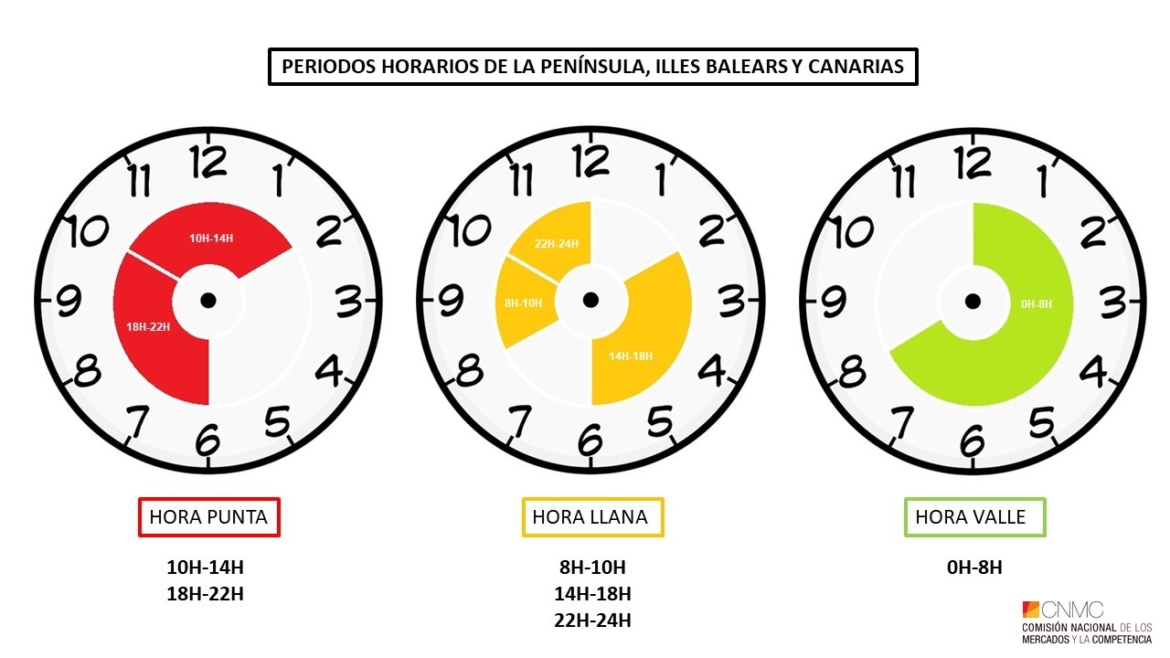Starting in June of the present year, a new billing methodology for tolls and charges on electricity bills will be established. Therefore, every domestic user will now have hourly discrimination in three periods of time regarding the tolls and charges on electricity bills, as reflected in the BOE and the newsletter of the National Commission of Markets and Competition (CNMC, according to its abbreviation in Spanish).
Which are the most important changes?
Part of the price that we pay for energy is paid to enterprises in charge of transport and distribution, and other concepts related to electricity such as tariff deficit, retribution on efficient renewable generation or the costs of non-peninsular territories. The percentage that they receive is calculated according to what we know as access tariffs. In a domestic level, the 2.5A toll was applied to most clients so far, meaning that approximately the same price will be applied during all hours of the day. Meanwhile, the rest of the clients had the 2.0DHA or 2.0DHS toll, meant to contracts with hourly discrimination (DH, according to its abbreviation in Spanish).
However, from the 1st of June, this three modalities will be united receiving the name of 2.0DT, which has two terms for hired power and three terms for used energy in the domestic sector, depending on the day of the week and the hour of the day. Due to this new distribution, working days (Monday to Friday) will have six different time slots while weekends and holidays will have the same one during the whole day. Keeping track of what times of the day energy use is cheaper or more expensive will be a challenge.
Therefore, three time periods will be included in the energy term, from more expensive to cheaper: Peak (P1), Average (P2) and Low (P3).The time distribution will be as follows:

The hired power will also have a different price depending on the hours of the day but, in this case, there will only be two periods; a more expensive one corresponding to the P1 and P2 hours of the energy term, and a cheaper one corresponding to the P3 hours.
Is there any additional paperwork required?
No. The new tariffs could start to be applied automatically from November 2020 in every retailer.
Despite this fact, and given that domestic users will be billed for two power terms, we will be able to decide having two different hired powers. Therefore, it will be interesting to know which time of the day we should use household items that use more power, and adapt the hired power to this time.
Which will be the prices for each period and power term?
The prices that fit every access toll and fees (both power and energy) for every time period are the ones shown below:
| Period | Power (€/kW/any) | Energy (€/kWh) |
| P1 – Peak | 30,6727 | 0,133118 |
| P2 – Average | 0,041772 | |
| P3 – Low | 1,42436 | 0,006001 |
However, the charges and fees will represent around 40% of the bill. Therefore, to these prices it will be necessary to add the commercialization margins, the cost of energy, the electricity tax and the VAT.
What will I pay in my bill?
All of these changes correspond to the access charges and fees paid by the supplier to the distributor, but this does not mean that your tariff is ruled by these hours. It will be the regulated market’s case, but other types of tariffs that follow different time periods can be offered in the free market.
Furthermore, the energy cost is variable in the regulated market. To know how much you will pay, you can check the prices of every hour of the next day in this page every day at 20h.
What can I do to save costs?
To save money in this new billing method, you can follow the following recommendations:
- Use energy during the average and low periods, but avoid the intensive use of energy during the peak period because it is considerably more expensive.
- Hire the powers according to your needs. They will make it easier for you if you are in the regulated market, because the maximum power that you have reached in previous months will be indicated in your bill. During 1 year, you will have the option of making two free power changes.
- If you have electric radiators that work with accumulated heat, take advantage of the night to charge them. And if you have a thermoelectric heater for hot water you can also turn it on only at the most economical time slots.
- Remember that the whole weekend is in the low period! It will be a good moment to cook for the week or do the laundry.



